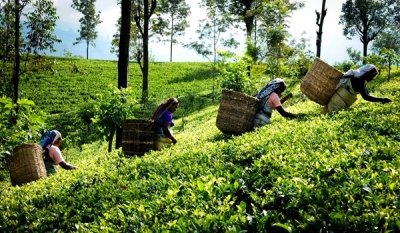He notes that while productivity is a multifaceted issue, labour productivity in Sri Lanka can and must improve substantially for the industry’s survival and even the estate worker unions have recognized this by pledging to improve productivity, including at the discussions on the last collective agreement on plantation sector wages in April 2013.
It is critical for the industry’s survival that such pledges are honoured, especially in the light of sharp decline of prices of both major crops cultivated by the Regional Plantation Companies – tea due to crises in its main export markets and rubber due to a slump in the world market.
With labour costs accounting for 67% - 70% of the total, cost of production of tea cannot be reduced without substantial increase in labour productivity, the Chairman of the Planters’ Association, which represents 23 Regional Plantation Companies collectively employing nearly 200,000 workers, points out.
Comparatively lower labour productivity but higher labour costs, is creating a situation in which the plantation sector is fast becoming financially unviable, Rajadurai cautions.
For instance, while a Kenyan worker who plucks an average of 48kg receives roughly US$ 2 a day, a counterpart in Sri Lanka who plucks 18kg, slightly above a third of the former amount, receives approximately US$ 4.6 per day – more than double the amount received by a Kenyan worker – despite the significantly less output.
Even in Assam in India, where the major portion of Indian tea production is located, the comparative daily labour wage is close to US$ 2 whilst the daily output is in the region of 28kg, he reveals.
While internal country-specific outputs and wages will necessarily differ, as tea – and thus by extension Ceylon Tea – is treated as a generic product, it is sold at more or less uniform world market prices, thus leading to producers from high cost countries such as Sri Lanka suffering massive losses.
Tea producers in any country get less than one to two per cent of the profit, whenever profits are earned, while supermarket retailers and blenders make profits from tea in tea consuming markets overseas, Rajadurai points out.
Based on the records of the Planters’ Association, collectively, 19 Regional Plantation Companies (RPCs) made a massive loss of nearly Rs. 2,850 million on rubber and tea in 2014.
With low prices due to external factors colluding with high production costs, at present most of the RPCs are reporting losses of Rs. 70 and Rs. 50 per kilogramme of rubber and tea sold respectively.
“While it is understandable that workers expect wage increases, the feasibility is very important given that companies have to pay them from income earned from tea and rubber auctions, prices at both of which have been severely depressed due to external reasons,” Planters’ Association of Ceylon Chairman, Roshan Rajadurai said.
“Plantation companies have made numerous efforts including introducing contract plucking, but clearly labour productivity has to improve significantly.
We have been reasonable in our demands and substantial increase in productivity is quite possible as workers themselves have shown in some occasions. The industry’s survival is now up to them.”
Rajadurai recalled that generally, in the past, plantation workers have willingly stood together and cooperated with the planters on the estates to protect the industry whenever there was a peril in the plantations and to their livelihoods.
“This time too we are confident that saner counsel will prevail and that the workers and their unions would in the same manner work in partnership in order to preserve the long term viability and the sustainability of this industry while we are going through these current challenges.
The plantation industry must thrive in order that we can give opportunities for earning and livelihood sustenance for over one million people that are resident and whose quality of life will depend on the relative fortunes of the plantation industry.
If the industry collapses, where would all these people go for employment in order to sustain their livelihoods?”
“Some of the beneficial schemes that the Government has introduced such as the payment of Rs. 80 for green leaf and the rubber latex subsidy scheme is unfortunately applicable only to the smallholders and not to the Regional Plantation Companies whose responsibilities, liabilities and commitments to the workers are however far greater.
The government should have included all the producers in these schemes instead of being selective.
We have taken up this matter on numerous occasions with the concerned officials and authorities.”
Plantation companies have continued to contribute strongly towards the welfare of employees despite these difficulties, Rajadurai observed.
“In spite of severe financial constraints, plantation companies have invested heavily in improving the living conditions of the nearly one million population residing in Regional Plantation Company estates, despite only 200,000 or 20% of them being our workers,” he added.
Since privatisation, within a span of 20 years from 1992 to 2012, RPCs have committed capital investments to the tune of Rs. 55 billion towards improving the fields, factories, living conditions, social infrastructure and other amenities in our plantations.
While we are fully aware that much needs to be done, health, education and economic indicators show that living conditions in RPC estates have improved greatly since privatization and are among the world’s best in the plantation sector.
This is no mean task, especially considering that the estate sector population has grown significantly since privatization.
Whenever the government requested, the RPCs have willingly allocated seven perch blocks of land in estates for the construction of individual worker houses apart from releasing land for other amenities relating to housing schemes.”
Records maintained by the Plantation Human Development Trust (PHDT) indicate that since privatization, 60% of workers of Regional Plantation Companies have been provided new or upgraded houses with the construction of 28,000 new cottage-type houses and the full upgrading of 112,000 line rooms.
RPCs also incur significant costs in providing numerous other benefits to the workers such as the statutory benefits of EPF, ETF, Gratuity, 17 days of paid holidays per year, attendance bonuses, maternity leave and benefits etc.
This is in addition to the free housing, water, sanitation, healthcare and childcare facilities that are provided not only to the workers but to all residents of RPC estates, Rajadurai noted.
He also said that RPCs are providing guaranteed family employment of 300 days of work to their employees and advances are being paid during months in which it is not possible to provide work due to bad weather etc. (with settlement being made in instalments in subsequent months), despite claims to the contrary.
However, RPCs have noticed a trend of high worker absenteeism with many workers foregoing opportunities to earn, regarding which RPCs have no control, he elaborated, noting however that the uncertainty of worker turnout has created serious issues which are detrimentally affecting routine agricultural operations.



























